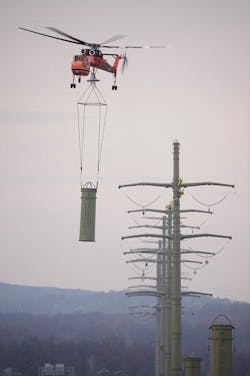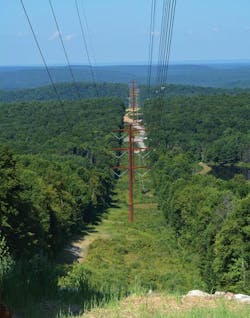The Susquehanna–Roseland project was energized on May 11, 2015. It was a great moment for Public Service Electric and Gas Co. (PSE&G), PPL Electric Utilities and the states of Pennsylvania and New Jersey, through which the transmission line passes.
PJM, the regional transmission operator that operates the electric grid in New Jersey and other nearby states, first mandated the S-R project in 2007 to address reliability issues that would begin affecting the grid in 2012. While PJM has been able to implement short-term fixes over the last three years, S-R was essential to ensure the long-term stability of the grid.
The project consisted of constructing a new 500-kV line, to augment an existing 80-year-old line operating at 230 kV, from the Susquehanna station in Berwick, Pennsylvania, to PSE&G’s Roseland switching station in Roseland, New Jersey. This required PPL and PSE&G to rebuild the towers to carry both lines. PSE&G built the 45-mile (72-km) section of the line in New Jersey, and PPL built the 101-mile (163-km) Pennsylvania portion.
Protecting Nature
The S-R project presented several complex engineering and construction challenges, none greater than the need to build the line across environmentally sensitive areas, including wetlands and a 4-mile (6.5-km) stretch through the Delaware Water Gap National Recreation Area. PSE&G took a number of steps to minimize the impact on these areas, including their native plants and wildlife. For example, where possible, helicopters were used to transport crews and install towers. This eliminated trucks, cranes and other project equipment from traveling in these environmentally sensitive areas.
By using the Erickson Aircrane for construction on this project, crews were able to avoid approximately 6 miles (9.7 km) and 13 acres (5.3 hectares) of access roads, and save nearly 1,000 trees within mature forested landscapes. In addition, the original plan involved building a road that would have impacted more than 45 acres (18 hectares) of wetland. Instead, less than 1 acre (0.4 hectares) of wetlands was impacted with the use of the helicopter.
The Erickson Aircrane was used for general delivery, long-line delivery and precision sets, which included conex boxes, concrete, mini excavators and tower sections. For this project, the Aircrane delivered more than 1 million tons (907,000 tonnes) of steel, with each delivery carefully planned and safely executed. Aircrane operations, which consisted of 314 lifts for 28 tower structures, were restricted to daytime hours and followed all applicable U.S. Federal Aviation Administration rules and regulations.
Right-of-Way Restoration
After the work was completed, there was a painstaking restoration of the right-of-way that required removal of more than 3 miles (4.8 km) of access roads, 16 work pads, three staging areas, tons of stone and thousands of wetland mats. The ground was then regraded and spread with new topsoil. Native seed mixes with species customized to the particular habitat were planted.
Coils also were installed on the lines at strategic locations frequented by American bald eagles to make it easier for the birds to see and avoid the lines. Bird-strike monitors, which alert officials if a bird strike occurs, also were installed. The U.S. National Park Service (NPS) was so pleased by the extensive measures taken that Kathleen Sandt, a spokeswoman for the NPS, said, “If you have to have somebody building a power line in your backyard, these folks [PSE&G] are great to work with.”
S-R also required significant work at PSE&G’s Roseland station, which, in addition to being the eastern end of the S-R line, also serves as the terminal point for two other strategic projects. The S-R team was responsible for building the 230-kV gas-insulated switchgear (GIS) for these projects as well as the 500-kV GIS for S-R.
Although the cost associated with building GIS is higher, the footprint needed is smaller, and this became the key point in favor of the GIS configuration. Concerns about the environmental impact of S-R were a big factor; therefore, using GIS enabled PSE&G to make the design as compact as possible and not impact sensitive wetlands and preserved lands.
S-R also required the construction of a green field 500-kV GIS station at Hopatcong. This station was the biggest earthwork project PSE&G has done since the Hope Creek nuclear plant, as it required the removal of rock to a depth of 20 ft (6 m). Hopatcong was placed in service in April 2014. It now serves as a four-way juncture for the existing north-south Branchburg to New York line and the east-west S-R line.
The Case for S-R
Communications and Public Outreach were other significant elements in bringing the project to this important milestone. “The difference between our project and the other transmission projects is that we were doubling the size of some of the towers, and were going through some rural residential areas,” said Senior Director John Ribardo, who had lead oversight of the S-R project. “People were concerned about their property values, construction impacts, electromagnetic fields, and the esthetics of the new taller towers. There was a small but vocal opposition who worked against the project.”
To counter this, the regional public affairs and corporate communications teams executed a communications plan aimed at explaining the need for this project and addressing the concerns it raised. Director George Sous played a lead role in the outreach efforts. Since much of the line passes through towns not in the PSE&G service area, he had to build a brand in the area. Using the same approach as in the PSE&G territory — getting involved in the same nonprofits and volunteer organizations — he was able to build some strong relationships and gradually make the case.
The project team built a communications program to ensure a consistent message, including a public website with a wealth of project-related information. Many of the municipalities traversed chose to link to this site from their official sites, which helped to ensure residents and other stakeholders received consistent messages and the most accurate information possible.
Grow and Prosper
The innovative construction techniques used, combined with the rigorous steps PSE&G took to mitigate environmental impact, resulted in a net benefit to the region’s natural resources. If S-R shows anything, it demonstrates utilities can replace and upgrade infrastructure in an environmentally responsible manner. That is precisely what the electric utility industry must do if the states being served are going to continue to grow and prosper.
Acknowledgments
From the outset, PSE&G encountered a number of significant permitting and outreach challenges with the S-R project, and a great deal of hard work went into overcoming them. Senior Director John Ribardo’s steadfast leadership throughout the project was critical to the project’s success. Senior Director Rob Pollock’s work with the NPS and New Jersey Department of Environmental Protection won the necessary approvals to begin construction. Director George Sous, who led the public outreach program, did a great job of working with all the stakeholders involved to gain the support needed to move forward. The assistance rendered by Jodi Moskowitz and David Richter of the law department was invaluable.
S-R also presented several difficult engineering, construction and environmental challenges, and the project managers — Randy Koncelik and Jason Kalwa on the overhead portions, and Tom Coates, Mike Fraraccio and Mike Moran on the inside plant side — rose to every one of them. Paul Drake, Dave Grossmueller and Claudia Rocca of the environmental licensing and permitting team did a marvelous job of securing permits, keeping the project environmentally compliant, and restoring the right-of-way in the National Park once work was completed. Project Manager Linda Engelhardt, contractor Jim Garvey and the program management team from Burns & McDonnell — Al Cretella, Matt Durocher, David Carr and Ragner Reyes — all did outstanding work on the project.
Many others across PSE&G and its delivery projects and construction group played important roles in keeping S-R on track. S-R was a total team effort, and all those who were involved in any aspect of the project can be justifiably proud this complex project is now in service.
Kim C. Hanemann ([email protected]) is senior vice president of delivery projects and construction for Public Service Electric and Gas Co. She is responsible for ensuring execution of the utility’s large transmission construction projects. She also manages new competitive transmission opportunities for PSE&G and the Federal Emergency Management Agency hardening projects on facilities operated by PSEG Long Island.
A Comprehensive Approach to Environmental Stewardship
When PSE&G received the New Jersey Department of Environmental Protection (DEP) wetlands and flood hazard permits needed to commence construction in the Delaware Water Gap National Recreation Area, the focus moved to ensuring compliance with the terms of the permits. Concerns about the impact that work would have on the hibernacula (winter habitats) of several threatened and endangered species — including the timber rattlesnake, bog turtle, wood turtles and the Indiana bat — prompted the DEP to require PSE&G to provide certified monitors to protect these species. The agency also made the construction and restoration standards part of the permits. All the threatened and endangered species were covered in the construction and restoration standards.
Using a vendor that specialized in providing certified wildlife monitors, Senior Permitting Specialist Dave Grossmueller, who was responsible for the monitoring effort, secured the services of monitors certified by the DEP for timber rattlesnake and wood turtles and by the U.S. Fish & Wildlife Service for the bog turtle.
“We send a monitor into a site before work begins to make sure that there is nothing there,” Grossmueller said. “We then put silt fencing around the site. However, rattlesnakes are determined, so if they do enter a site, the monitor’s job is to safely remove them using a snake hook. The last thing you want to do with a venomous snake is handle it if you don’t have to.”
Monitors also ensure that PSE&G’s work does not affect the bog and wood turtles. For example, the silt fencing the utility used has engineered openings (called critter crossings) that allow the turtles to pass through them. The main challenge was ensuring that there were enough monitors to cover all our sites each day. “That’s where the vendor came in,” Grossmueller said. “They have a number of people who are certified in bog turtles.”
This rigorous approach to monitoring sites helped ensure compliance with the terms of the permit and to minimize the impact on these species. This, taken in combination with the thorough restoration work performed after the construction phase, helped build credibility with environmental regulators.
“Our work along the S-R right-of-way has been painstaking, but it demonstrates that we can be trusted to be responsible stewards of the environment,” said Rob Pollock, delivery projects and construction’s senior director of environmental projects and permitting. “I believe this will help us in pursuing new opportunities, particularly if it involves projects that traverse environmentally sensitive areas.”






